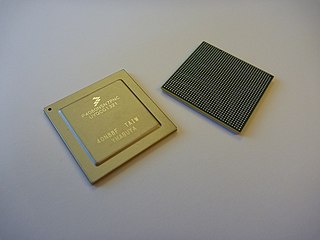
PowerPC is a reduced instruction set computer (RISC) instruction set architecture (ISA) created by the 1991 Apple–IBM–Motorola alliance, known as AIM. PowerPC, as an evolving instruction set, has been named Power ISA since 2006, while the old name lives on as a trademark for some implementations of Power Architecture–based processors.

The Motorola DSP56000 is a family of digital signal processor (DSP) chips produced by Motorola Semiconductor starting in 1986 with later models are still being produced in the 2020s. The 56k series was quite popular for a time in a number of computers, including the NeXT, Atari Falcon030 and SGI Indigo workstations all using the 56001. Upgraded 56k versions are still used today in audio equipment, radar systems, communications devices and various other embedded DSP applications. The 56000 was also used as the basis for the updated 96000, which was not commercially successful.

The Freescale 683xx is a family of compatible microcontrollers by Freescale that use a Motorola 68000-based CPU core. The family was designed using a hardware description language, making the parts synthesizable, and amenable to improved fabrication processes, such as die shrinks.
Serial Peripheral Interface (SPI) is a de facto standard for synchronous serial communication, used primarily in embedded systems for short-distance wired communication between integrated circuits.

Freescale Semiconductor, Inc. was an American semiconductor manufacturer. It was created by the divestiture of the Semiconductor Products Sector of Motorola in 2004. Freescale focused their integrated circuit products on the automotive, embedded and communications markets. It was bought by a private investor group in 2006, and subsequently merged into NXP Semiconductors in 2015.
PowerPC G4 is a designation formerly used by Apple and Eyetech to describe a fourth generation of 32-bit PowerPC microprocessors. Apple has applied this name to various processor models from Freescale, a former part of Motorola. Motorola and Freescale's proper name of this family of processors is PowerPC 74xx.
CodeWarrior is an integrated development environment (IDE) published by NXP Semiconductors for editing, compiling, and debugging software for several microcontrollers and microprocessors and digital signal controllers used in embedded systems.
PowerQUICC is the name for several PowerPC- and Power ISA-based microcontrollers from Freescale Semiconductor. They are built around one or more PowerPC cores and the Communications Processor Module which is a separate RISC core specialized in such tasks such as I/O, communications, ATM, security acceleration, networking and USB. Many components are System-on-a-chip designs tailor-made for embedded applications.

NXP Semiconductors N.V. (NXP) is a Dutch semiconductor designer and manufacturer with headquarters in Eindhoven, Netherlands. The company employs approximately 31,000 people in more than 30 countries. NXP reported revenue of $11.06 billion in 2021.
The PowerPC e500 is a 32-bit microprocessor core from Freescale Semiconductor. The core is compatible with the older PowerPC Book E specification as well as the Power ISA v.2.03. It has a dual issue, seven-stage pipeline with FPUs, 32/32 KiB data and instruction L1 caches and 256, 512 or 1024 KiB L2 frontside cache. Speeds range from 533 MHz up to 1.5 GHz, and the core is designed to be highly configurable and meet the specific needs of embedded applications with features like multi-core operation interface for auxiliary application processing units (APU).
The i.MX range is a family of Freescale Semiconductor proprietary microcontrollers for multimedia applications based on the ARM architecture and focused on low-power consumption. The i.MX application processors are SoCs (System-on-Chip) that integrate many processing units into one die, like the main CPU, a video processing unit, and a graphics processing unit for instance. The i.MX products are qualified for automotive, industrial, and consumer markets. Most of them are guaranteed for a production lifetime of 10 to 15 years.
Devices that use i.MX processors include Ford Sync, the Amazon Kindle and Kobo eReader series of e-readers until 2021, Zune, Sony Reader, Onyx Boox readers/tablets, SolidRun SOM's, Purism's Librem 5, some Logitech Harmony remote controls and Squeezebox radio and some Toshiba Gigabeat MP4 players. The i.MX range was previously known as the "DragonBall MX" family, the fifth generation of DragonBall microcontrollers. i.MX originally stood for "innovative Multimedia eXtension".
The PowerPC e700 or NG-64 were the codenames of Freescale's first 64-bit embedded RISC-processor cores.

QorIQ is a brand of ARM-based and Power ISA–based communications microprocessors from NXP Semiconductors. It is the evolutionary step from the PowerQUICC platform, and initial products were built around one or more e500mc cores and came in five different product platforms, P1, P2, P3, P4, and P5, segmented by performance and functionality. The platform keeps software compatibility with older PowerPC products such as the PowerQUICC platform. In 2012 Freescale announced ARM-based QorIQ offerings beginning in 2013.

The ARM Cortex-A9 MPCore is a 32-bit multi-core processor that provides up to 4 cache-coherent cores, each implementing the ARM v7 architecture instruction set. It was introduced in 2007.

Integrated Device Technology, Inc., is an subsidiary of Renesas Electronics headquartered in San Jose, California, that designs, manufactures, and markets low-power, high-performance mixed-signal semiconductor products for the advanced communications, computing, and consumer industries. The company markets its products primarily to original equipment manufacturers (OEMs). Founded in 1980, the company began as a provider of complementary metal-oxide semiconductors (CMOS) for the communications business segment and computing business segments. The company focuses on three major areas: communications infrastructure, high-performance computing, and advanced power management.
Communications Processor Module (CPM) is a component of Motorola 68000 family (QUICC) or Motorola/Freescale Semiconductor PowerPC/Power ISA (PowerQUICC) microprocessors designed to provide features related to imaging and communications. A microprocessor can delegate most of the input/output processing to the Communications Processor Module and the microprocessor does not have to perform those functions itself. Some input/output functions require quick response from the processor, for example due to precise timing requirements during data transmission. With CPM performing those operations, the main microprocessor is free to perform other tasks.






